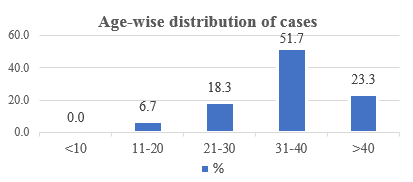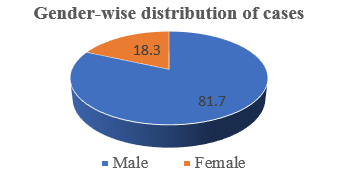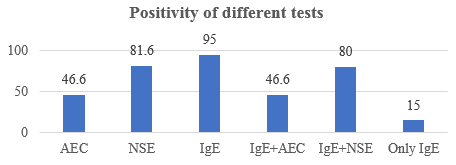- Received October 16, 2021
- Accepted October 21, 2021
- Publication November 26, 2021
- Visibility 4 Views
- Downloads 0 Downloads
- DOI 10.18231/j.jdpo.2021.061
-
CrossMark
- Citation
Correlation of absolute eosinophil count, nasal smear eosinophilia and serum IgE levels in allergic rhinitis
- Author Details:
-
Shruthi Gowthami M R *
Introduction
Allergy is a rapid immunologic reaction occurring in a previously sensitized individual that is triggered by the binding of an antigen to IgE antibody on the surface of mast cells. [1] The association between eosinophils and allergic diseases has been known since many years. [2] Allergic rhinitis (AR) is one of the most common disease in India. [3] Allergic Rhinitis is a clinical condition which involves nasal mucosal disorder induced after allergen exposure resulting from an IgE-mediated inflammation of the membrane of nose.[4] Allergic Rhinitis is a global health problem, which results in significant disability worldwide. It cuts across all ages, ethnic groups, socioeconomic status and countries, estimated to affect about 10 – 25% of World population (> 500 million people).[3] The prevalence of allergic rhinitis in India is 10-20% and has increased during the last two - three decades and it continues to increase. [5] AR impairs the quality of life and leads to significant expenses for its treatment and care. [6]
The presence of 2 or more allergic symptoms, occurring for more than one hour on most days is suggestive of allergic rhinitis. These symptoms include, watery rhinorrhea, sneezing (often paroxysmal), nasal obstruction (usually bilateral), nasal itch, with or without conjunctivitis.[7] Most AR patients can be diagnosed by a combination of history, clinical examination and allergy tests such as skin prick test, radioallergosorbent test for specific IgE, absolute eosinophil count (AEC), total serum IgE level, and nasal cytology for eosinophils.[8] An absolute eosinophil count is a blood test that measures the number of one type of white blood cells called eosinophils. Nasal smear cytology for eosinophils is an objective investigation, which involves the laboratory preparation and subsequent analyses of nasal scrapings from the inferior turbinate with the aim of determining the eosinophil count and categorizing such patients based on the amount seen microscopically. Nasal smear cytology has been found to be a useful diagnostic test with a moderately high sensitivity and a high specificity. [9]
An immunoglobulin E(IgE) test measures the level of IgE, a type of antibody. Elevated concentrations of IgE are generally thought of in context of allergic disease.
Objective
To correlate Nasal smear eosinophilia (NSE), blood absolute eosinophil count (AEC) and total serum IgE levels with severity of the clinical score in patients with allergic rhinitis.
Materials and Methods
The current study is a one-year prospective study from June 2020 to May 2021. The sample size is 60. Patients with clinical diagnosis of allergic rhinitis who came to Pathology department from the department of ENT were included as study participants. The patients who are on Anti-histamines and known asthma cases were excluded from the study.
Symptom score for Allergic Rhinitis (SFAR) Score[10] was collected from the patients’ case sheet. Also, patients were orally asked to confirm the same. Based on the score, the patients were divided into mild, moderate and severe. Blood AEC levels were calculated using differential counts given by hematology analysers. Also manually done through peripheral smear with EDTA anticoagulated venous blood. The normal absolute eosinophil count is 40-440 cells/cumm. It was graded as mild, moderate and severe eosinophilia. Mild eosinophilia: 450-1500 cells/cumm, Moderate eosinophilia: 1500-5000 cells/cumm, Severe eosinophilia: >5000 cells/cumm. [11]
After explaining the procedure, nasal smears were taken from either nostril using a cotton swab from the nasal septum and inferior turbinate. Two smears were prepared from each patient. Smears were dried and stained with Leishman and Giemsa stains. Stained smears were examined under microscope and differential score obtained. It was graded as mild, moderate and marked nasal smear eosinophilia. Normal (Grade 0): Eosinophil% less than 10% of total leukocytes. Mild (Grade 1):10-16% of total leukocytes. Moderate (Grade 2): 16-25% of total leukocytes. Severe (Grade 3): >25% of total leukocytes.
IgE levels were immunologically measured using Chemiluminescence assay. Serum IgE levels <100 IU/ml is negative. It is elevated if serum IgE levels are >100 IU/ml.
Data was analysed using SPSS software.
Results
Majority (51.7%) of the patients were between 31-40 years (Fig. 1). The mean age of patients was 35.2 years. Males (81.7%) were more in number as study participants (Fig. 2). The distribution of cases according to severity of symptoms is as follows; Mild- 21(35.0%); Moderate-17(28.3%) and Severe- 22(36.7%). The mean of Blood AEC was 753.95 cells/cu.mm; NSE was 19.9% and IgE was 586 IU/ml. The correlation of NSE and Blood AEC grades with severity of symptom score is shown in table 1. There was good correlation of NSE grade with severity of clinical score; p 0.002. But there was no correlation of blood AEC with severity of clinical score. There was good correlation of NSE and serum IgE with clinical severity score as evidenced by significant increase in mean values of NSE and serum IgE with the severity of clinical score. It is statistically significant (p<0.05) as shown in table 2.
|
Tests |
Symptom score |
||
|
NSE |
Mild |
Moderate |
Severe |
|
0 |
8 (13.4%) |
3 (5.0%) |
0 |
|
1 |
3 (5.0%) |
3 (5.0%) |
2 (3.3%) |
|
2 |
8 (13.3%) |
9 (15.0%) |
8 (13.4%) |
|
3 |
2 (3.3%) |
2 (3.3%) |
12 (20.0%) |
|
Total |
21 (35.0%) |
17 (28.3%) |
22 (36.7%) |
|
Blood AEC |
Mild |
Moderate |
Severe |
|
No Eosinophilia |
21 (35.0%) |
8 (13.3%) |
3 (5.0%) |
|
Mild |
0 (0.0%) |
4 (6.6%) |
9 (15.0%) |
|
Moderate |
0 (0.0%) |
5 (8.3%) |
9 (15.0%) |
|
Severe |
0 (0.0%) |
0 (0.0%) |
1 (1.7%) |
|
Total |
21 (35.0%) |
17 (28.3%) |
22 (36.7%) |
|
Symptoms score |
Mean of NSE (%) |
Mean of IgE (IU/ml) |
|
Mild |
10.7 |
439.7 |
|
Moderate |
19 |
630.5 |
|
Severe |
29.4 |
741.1 |




Discussion
Majority (51.7%) of the patients were between 31-40 years in our study whereas in a study by Prabhakaran J et al [12] majority (43%) of patients were between 15-30 years. Males were more in number as study participants constituting 81.7% whereas in a study by Prabhakaran J et al [12] 56% were males. Mean Absolute eosinophil count in the present study was found to be 753.95 cells/cu.mm whereas in study by Agarwal A et al [6] it was 553cells/cu mm. Mean Serum IgE was found to be 586 IU/ml concordant with findings by Agarwal A et al [6] where mean Serum IgE was 603.7IU/ml. Highly varied values were seen across various other studies conducted. [13] There was no correlation of blood AEC with severity of clinical score in our study. Similar observation was made by Anand K Patel et al study. [14]
Like in our study, in a study by Berkiten G et al, [15] there was a positive correlation between nasal eosinophilia score and Total Nasal Symptom Score (r = 0.652; p < 0.05) in persistent allergic rhinitis and intermittent allergic rhinitis patients. In a study by Prabhakaran J et al [12] the clinical severity had a strong positive correlation with nasal smear eosinophil count (p value 0.001) when compared with that of blood absolute eosinophil count (p value 0.062).
A study by Vaidya K A et al [16] showed Nasal eosinophilia in 90% and Blood eosinophilia in 94% of cases of clinically diagnosed allergic rhinitis. There was a good correlation of nasal smear eosinophilia with blood AEC in allergic rhinitis and with histological findings in cases of allergic nasal polyps.
Conclusion
NSE and IgE both correlated well with severity of the disease. Nasal smear cytology is a simple procedure having good correlation with severity of clinical score should be used routinely. Testing for serum IgE levels will increase the accuracy with a better diagnostic utility.
Conflict of Interest
The authors declare that there are no conflicts of interest in this paper.
Source of Funding
None.
References
- V Kumar, A K Abbas, J C Aster. Robbins and Cotran Pathologic Basis of Disease; Diseases of the immune system. 9th Edn. 2015. [Google Scholar]
- K Jagadeeshwar, V Venumadhav, V Sangram, S Chowdary, S Rani, V Kumar. A study on serum Ige levels, peripheral eosinophils and individual symptoms in patients with non-infective rhinitis and asthma and related conditions research article. Int J Pharm Pharm Sci 2012. [Google Scholar]
- D Chandrika. Allergic rhinitis in India: an overview. Int J Otorhinolaryngol Head Neck Surg 2017. [Google Scholar]
- J Bousquet, P Van Cauwenberge, N Khaltaev. ARIA Workshop Group, World Health Organization. Allergic Rhinitis and it's impact on asthma. J Allerg Clin Immunol 2001. [Google Scholar] [Crossref]
- D Y Wang, M Niti, J D Smith, K H Yeoh, T P Ng. Rhinitis:Do diagnostic criteria affect the prevalence and treatment?. Allergy 2002. [Google Scholar]
- A Agrawal, R Chandan. The diagnostic utility of Serum IgE and Absolute eosinophil count in cases of Allergic Rhinitis. Trop J Pathol Microbiol . [Google Scholar]
- S G Johansson, J O Hourihane, J Bousquet, C Bruijnzeel-Koomen, S Dreborg, T Haahtela. A revised nomenclature for allergy. An EAACI position statement from the EAACI nomenclature task force. Allergy 2001. [Google Scholar]
- J Bousquet, N Khaltaev, A A Cruz, J Denburg, W J Fokkens, A Togias. Allergic Rhinitis and its Impact on Asthma (ARIA) 2008 Update (in collaboration with the World Health Organization, GA2LEN). Allergy 2008. [Google Scholar]
- S G Johansson, J O Hourihane, J Bousquet, C Bruijnzeel-Koomen, S Dreborg, T Haahtela. A revised nomenclature for allergy. An EAACI position statement from the EAACI nomenclature task force. Allergy 2001. [Google Scholar]
- F E Ologe, S O Adebola, A D Dunmade, K A Adeniji, B A Oyejola. Symptom Score for Allergic Rhinitis. Otolaryngol-Head Neck Surg 2013. [Google Scholar]
- F Brito-Babapulle. The eosinophilias, including the idiopathic hypereosinophilic syndrome. Br J Haematol 2003. [Google Scholar] [Crossref]
- J Prabakaran, E Dhanapal, V Prasanna, S Jayagar. Correlation between blood eosinophil count and nasal smear eosinophils with severity of clinical score in allergic rhinitis patients- A cross sectional study. J Med Sci Clin Res 2018. [Google Scholar]
- M S Tegnoor, Oba Jabri, M V Kumar, V Kurle. Assessment of serum IgE levels in patients of allergic rhinitis. Al Ameen J Med Sci 2017. [Google Scholar]
- A K Patel, T P Nagpal. Comparison of blood absolute eosinophil count and nasal smear eosinophils with symptoms and severity of clinical score in patients of allergic rhinitis. Indian J Allergy Asthma Immunol 2014. [Google Scholar]
- G Berkiten, I Aydogdu, T L Kumral, Z Salturk, Y Uyar, A Arslanoglu. Nasal eosinophilia in nasal smears of patients with persistent and intermittent allergic rhinitis. J Laryngol Otol 2018. [Google Scholar]
- K A Vaidya, S Pai, T Nagaraj, Sukesh. A study on utility of nasal smear examination in diagnosing allergic rhinitis and its histopathological correlation in allergic nasal polyps. Int J Basic Appl Med Sci 2015. [Google Scholar]
